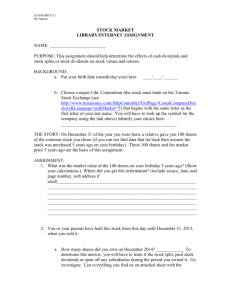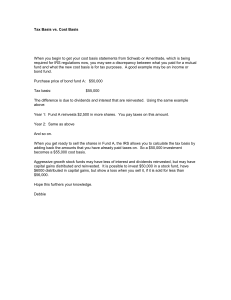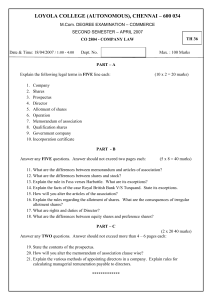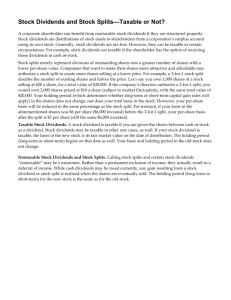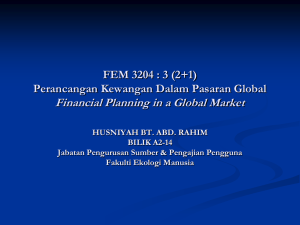CeFS Why Money Matters
advertisement
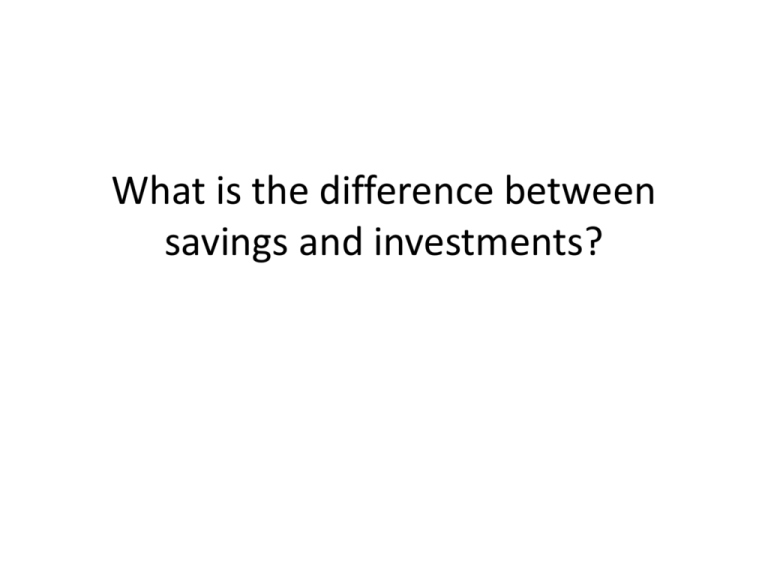
What is the difference between savings and investments? Savings and investments compared Savings Investments Earn interest – typically <5% Return in form of capital growth, dividends or both Higher return than from savings Risk that investment falls in value Investment solutions: Shares/’equities’, funds, unit trusts, investment trusts Longer term than savings Money can only increase due to interest Secure Low risk: Low reward Savings solutions: Deposit account, bond Capital growth v Income generating Capital growth • Shares / Equities - Part ownership of company. - Potential for capital growth if co does well and increases in value • National Savings and Investment (NS&I) - Very safe as Government issues them. - Capital gain likely to be lower • Property - Historically prices mover upwards. - Prices vulnerable to economic mood. Income generating • Bank interest - Many bank accounts pay interest on your money. • Dividends: sharing some of the companies profit on a 2x yearly basis. Not certain. • Bonds: invest in these and you are effectively lending your money. Receive fixed interest on your bond. • NS&I: Income bonds and pensioners guaranteed income bonds pay income in the form of interest. What Is AER? The return on savings is the interest that the provider pays the account holder and is expressed as an annual equivalent rate (AER), such as 2.2% AER. The AER is the interest that will be earned on the money in one year and takes into account how often the provider pays the interest (for example, monthly or annually) Return from investments – Shares (capital growth) You buy 100 shares in Marks and Spencer for £3 each Cost is £300 A year later they cost £4 each. £400 - £300= £100 ‘capital growth’ Alternatively, they cost £1 each £100 - £300 = £200 loss Only get the benefit of growth, or suffer the loss, if you sell the shares. Otherwise ‘paper gain/loss’ Return from investments – Dividends (income generating) Dividend is a share of profits. You buy 100 shares in Marks and Spencer for £3 each Marks and Spencer pay a dividend of 10p per share. You receive £10 in dividends paid to you by cheque/BACS Companies do not have to pay dividends. What borrowing solutions can you think of? Loan accounts Credit arrangements Mortgage loans Personal loans Overdrafts Credit cards Store cards Factors to consider: What time period do you have to pay it back? What interest rate will you pay? What could you use this solution to purchase? What are the advantages and disadvantages of each solution? Product Typical purchase Time period/Interest rate Advantages Disadvantages Mortgage Home purchase Typically up to 25 years. Some lenders offer 35-40 years. Typical rate 7% Have to pay legal and other fees Spreads cost of borrowing over long time period Large financial commitment Personal loan Car, household improvements 3-15 years typically. Can be up to 25 years. Maximum £25,000 Rates range from 7.5% - 19% Can choose amount and time period to repay. Can budget for payments. Set payments each month Overdraft Your choice. Unexpected expenses? As and when you need it. Range of rates 13.5% - 19% typical Flexible Expensive. Interest and fees. Credit card Your choice As and when you need it. Range of rates 15% - 20% typical. Can be higher Flexible. Required to repay minimum only Expensive. Can spend too much easily. Store card Limited to certain shops As and when you need it. Rates 25-30% Special offers. Expensive. Limited to certain shops.
